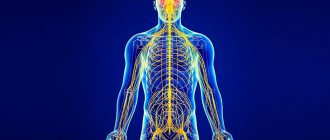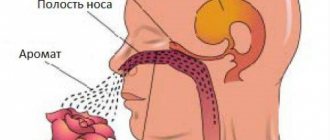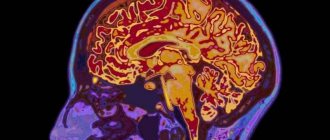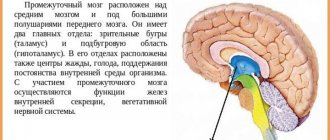Pineal gland hormones
Endocrine role of the pineal gland:
| Hormone | Effect on the body |
| Serotonin (mainly produced in the gastrointestinal tract) | - influences mood - protects against stress - activates the release of adrenaline |
| Melatonin | - ensures a good night's sleep - inhibits the secretory activity of the pituitary gland, thyroid, parathyroid, pancreas, thymus, ovaries and testes - affects reproductive health - has a positive effect on the activity of the cardiovascular and nervous systems - has antitumor properties |
| Adrenoglomerulotropin | - stimulates the secretion of cortisol, aldosterone |
| Pinealin | - hypoglycemic effect |
All biologically active substances of the pineal gland are divided into two groups:
- indoles;
- peptides.
The main hormones of the pineal gland, serotonin and melatonin, are indoles.
The serotonin molecule is similar to a substance that was first obtained from rye grain infected with the parasitic fungus ergot, is currently synthesized and is called LSD (lysergic acid diethylamide) https://ergotism.info/ru/absentis/lsd_03_serotonin.htm
Melatonin synthesis occurs at night from serotonin. The latter is synthesized and accumulated in the pineal gland during daylight hours.
Adrenoglomerulotropin is another hormone of the pineal gland. The basis for its formation is melatonin.
The influence of light and circadian rhythm (Afshin Shirani, Erik K. St. Louis) Research https://www.ncbi.nlm.nih.gov/pmc/articles/PMC2670336/
Suprachiasmatic nucleus (SCN) -
the main generator of circadian rhythms in mammals, regulates the release of hormones in the pineal gland, synchronizes the functioning of the body’s “biological clock”. With age, the functioning of the SCN deteriorates. Older people begin to have problems sleeping. Wikipedia
The group of peptides includes the following compounds: arginine-vasotocin, vasoactive intestinal polypeptide, neurophysins and others.
Dimethyltrypamine is a potent psychoactive hallucinogenic substance produced by the pineal gland. The endogenous delict was identified and described in 1972. Its physiological function has not been fully established. It is known to be a serotonin receptor agonist and relieve post-traumatic stress disorder.
Functions of pineal gland hormones
Biologically active substances that are synthesized by the pineal gland inhibit the bioelectrical activity of the brain.
What hormones does the pineal gland produce?
| Biologically active substance | Explanation and function |
| Melatonin | The main hormone of the gland, regulator of circadian rhythms |
| Serotonin | One of the main neurotransmitters in the body |
| Adrenoglomerulotropin | Affects the secretory activity of the adrenal glands |
| Dimethyltryptamine | Functions as a serotonin receptor agonist, psychedelic |
With an inadequate sleep-wake schedule and a disruption in the production of biologically active substances by the pineal gland, a person can develop arterial hypertension, cardiac dysfunction, and diabetes mellitus. In addition, such a daily routine is conducive to obesity.
To restore functional changes in the pineal gland, it is necessary to eliminate factors that have a negative impact on the functioning of the gland:
- Ensure adequate sleep at night and wakefulness during the day.
- Avoid prolonged work at the computer and excess artificial lighting.
- Avoid head injuries.
Melatonin
The pineal gland secretes melatonin into the blood, which is produced from serotonin and is involved in the regulation of circadian rhythms. The substance has virtually no effect on the depth of sleep. The pineal gland is the main source of melatonin in the human body (produces approximately 80% of this substance), in addition, melatonin is produced in the gastrointestinal tract (in particular, in the cells of the appendix) and a number of other organs.
Melatonin synthesis is blocked by bright light, the effect of which on the gland occurs through nerve pathways included in the photoneuroendocrine system. Melatonin is characterized by daily fluctuations in concentration. Its maximum level is observed between 00:00 and 05:00. Less melatonin is produced in summer and in winter. A change in the rhythm of production occurs when moving to other time zones.
With a normal daily routine (with sleep at night), a person produces 70% of the total daily production of melatonin at night. With insufficient sleep duration, its synthesis at night decreases and approaches daytime levels.
The functions of melatonin include:
- regulation of blood pressure;
- decreased mental and physical activity;
- slower growth and sexual development in children;
- increased antibody production;
- slowing down aging;
- participation in the regulation of the functions of the thyroid gland and thymus;
- inhibition of the production of gonadotropins, as well as other hormones of the anterior pituitary gland;
- decrease in the concentration of glucose and cholesterol in the blood;
- improving learning ability;
- antioxidant effect.
Melatonin is one of the few hormones that have nuclear and membrane receptors. Its transport is carried out through serum albumin, after being released from which melatonin binds to receptors located on the membrane of target cells and penetrates into the cell nucleus, where it produces its effect. Hydrolyzed in the liver and excreted in the urine.
With age, due to a decrease in the activity of the pineal gland, the level of melatonin decreases, which leads to the appearance of age-related sleep disorders (shallow sleep, insomnia). Also, a violation of melatonin secretion can occur against the background of stress, prolonged exposure to a computer monitor.
Violation of melatonin synthesis causes the following conditions:
- weekend insomnia;
- insomnia due to a shift work schedule;
- delayed sleep phase syndrome;
- jetlag (time zone change syndrome);
- daytime sleepiness;
- nightmares;
- deterioration of skin and hair condition;
- depressive states.
The role of the pineal gland in the body
The pineal gland is located between the cerebral hemispheres above the superior colliculus of the midbrain.
In the medical literature there are also such names for this endocrine gland - pineal gland, penial gland.
The role of the pineal gland in the body is to ensure the most important biological processes:
- regulation of sleep and wakefulness;
- influence on the pituitary gland and inhibition of growth hormone secretion;
- inhibition of puberty;
- strengthening the immune system;
- antioxidant effect;
- antitumor protection;
- the ability to slow down the aging process.
Pineal gland hormones and their functions: table
As already noted, in addition to melatonin, there are several other hormones produced by the pineal gland. A list of hormones and their studied functions is presented in the table.
| Hormones | Their functions |
| Melatonin | In addition to influencing sleep, melatonin is involved in regulating the function of all organs of the endocrine system in the human body. The organs and glands of the endocrine system - the pituitary gland, thyroid and parathyroid glands, thymus, pancreas, ovaries and testes - secrete their hormones into the blood. The pituitary gland stimulates the secretion of these hormones, and the pineal gland (thymus) regulates their inhibition through the neurohormone melatonin. Melatonin has been found to regulate certain human reproductive functions. It blocks the secretion of gonadotropins, luteinizing and follicle-stimulating hormones from the anterior pituitary gland. These hormones help in the proper development and functioning of the testes and ovaries. There is evidence that light exposure and associated melatonin levels may have an impact on women's menstrual cycles. Decreased melatonin may also play a role in the development of irregular menstrual cycles. There is evidence that melatonin may have positive effects on the heart and blood pressure, as well as atherosclerosis and hypertension. The size of the pineal gland may indicate the risk of developing certain disorders, and that lower melatonin levels may increase the risk of developing schizophrenia and other mood disorders. If the functions of the pineal gland are disrupted, it can also lead to hormonal imbalance. Some research suggests that there may be a link between pineal gland dysfunction due to long-term light exposure and the risk of cancer. |
| Adrenoglome-rulotropin | Melatonin, produced by the pineal gland, has the ability to transform into the hormone adrenoglomerulotropin, which selectively stimulates the secretion of aldosterone and cortisol. It is assumed that the control of aldosterone secretion may be associated with an excitatory inhibitory system, including interaction with corticotropin produced in the anterior pituitary gland, as well as with adrenoglomerulotropin and anticorticotropin of pineal origin. With the help of this system, the secretion of aldosterone in the glomerular cortex of the adrenal glands is controlled. This system involves volumetric receptors - stretch-sensitive nerve endings in various organs and vessels. |
| Serotonin | The pineal gland is the richest site of the neurotransmitter serotonin (the pleasure hormone) in the brain. This implies that the pineal gland is an important site of mood-related serotonergic system activity. If the endocrine system releases too many of its hormones (for example, during stress), the pineal gland releases melatonin to counteract them. For example, serotonin is released during stress, and an increase in the amount of this hormone causes the release of adrenaline, which allows the body to function during stressful loads. In the pineal gland, serotonin is converted to melatonin through an enzymatic reaction. It is noted that the pineal gland is a magnetically sensitive organ. This means that it is sensitive to electromagnetic fields (EMF) emitted by computer monitors, cell phones, microwave ovens, high voltage lines, etc. Electromagnetic fields suppress the activity of the pineal gland and reduce the production of melatonin and serotonin. |
| Dimethyltryp-tamine | In 1972, it was discovered that the pineal gland produces the powerful psychoactive hallucinogenic drug dimethyltryptamine (DMT). The endogenous psychedelic dimethyltryptamine is one of the most powerful psychedelic drugs naturally produced in animals and humans. DMT is also an alkaloid in some plants. When taken orally, DMT initiates a powerful psychedelic and often spiritual experience in a person. DMT use has deep roots in the culture of South American shamans and natural healers. The function of DMT in the human body has not yet been established, but dimethyltryptamine is thought to act as a 5HT2A serotonin receptor agonist. Dimethyltryptamine has also been reported to provide long-term relief from emotional trauma and mitigation of problems associated with post-traumatic stress disorder (PTSD). Active food mediators can increase the content of dimethyltryptamine in the human body. It is believed that the activity of the pineal gland is inhibited by sugar. Because of this, cleansing the body and consuming fresh, high-quality, organic nutrition can enhance the therapeutic benefits of this natural “medicine.” |
Hormonal disorders of the pineal gland
The most common pathological condition of the pituitary gland is a violation of circadian rhythms. Stress and prolonged work at the computer are the main causes of the disease. Prolonged exposure to light in the evening negatively affects the functioning of the pineal gland. Symptoms of the disease:
- disturbing sleep;
- insomnia;
- difficulty falling asleep;
- nightmares;
- drowsiness during the day.
Due to blockage of the epiphyseal duct, single and multiple cysts occur. The reason for their occurrence is stagnation in the gland tissue caused by the accumulation of the hormone. Its secretion continues, but the outflow is disrupted. Other causes of cystic formations are hemorrhages, the presence of helminths (echinococcosis). The main signs of the pathological condition:
- headache;
- night sleep disorder.
For unknown reasons, the cells of the pineal gland begin to transform. Pinealoma is a benign neoplasm .
Treatment of tumors of the pineal region. Computed tomography (a and b), after endoscopic ventriculostomy (c and d) Article in English: https://www.ncbi.nlm.nih.gov/pmc/articles/PMC4014815/
Malignant tumors develop less frequently. Their appearance is indicated by the following manifestations:
- violation of water-salt balance;
- jumps in body weight;
- headache;
- nausea, vomiting;
- decreased performance;
- impaired coordination of movements;
- difficulty walking;
- problems with speech and writing.
Dysfunction of the pineal gland is also associated with impaired blood supply due to injuries, blockage of blood vessels, and high blood pressure. Atrophy and degeneration of glandular tissue occurs with cirrhosis of the liver, infections, diabetes mellitus, and leukemia.
Inflammation of the pineal gland develops against the background of brain abscesses, tuberculosis, sepsis, and meningitis.
Pineal gland
(from the Greek epíphysis - growth, lump), 1) pineal gland, pineal gland, an organ of vertebrates and humans, located between the anterior tubercles of the quadrigeminal cerebrum and connected through a pedicle with the 3rd ventricle.
Evolutionarily, the origin of E. is associated with the parietal organ of some higher fish and reptiles. Comparatively anatomically, E. is considered as an organ of vision. In cyclostomes it has retained to a certain extent the structure of the eye; in tailless amphibians it is found in a reduced form under the scalp. In mammals and humans, E. has a glandular structure. During embryogenesis, E. develops from an outgrowth of the roof of the diencephalon. It consists of a large number of glial and epithelial cells - pinealocytes, separated by connective tissue septa. The mass of E. in humans is 100-200 mg.
The blood supply to the E. is carried out from the system of the carotid arteries, and the innervation is by sympathetic nerve fibers from the superior cervical ganglia.
The physiology of E. has not been sufficiently studied, mainly due to its small size, peculiarities of localization, and the multiplicity of functional connections with the diencephalon, endocrine glands, and other organs. E. cyclostomata is a photoreceptor organ. The endocrine nature of E.'s function has not been definitively established. Its activity decreases with age, and it itself acquires the character of a rudiment containing mineral deposits (carbonates, phosphates, calcium and magnesium) - the so-called “brain sand”, revealed on x-rays. Removal of E. in chickens leads to premature sexual development, and in mammals - to activation of the reproductive system. The administration of E. extracts to animals causes a decrease in the weight of the gonads, disrupts the development of sexual characteristics, and inhibits spermatogenesis. In castrated animals, the E. function is activated, and the introduction of estrogens inhibits it. E. contains an antigonadotropic substance that inhibits the action of gonadotropic hormones of the pituitary gland. In humans, with hypofunction of E. (Pelizzi's syndrome), the most pronounced change is the premature development of the genital organs and secondary sexual characteristics; with hyperfunction, the most pronounced change is the underdevelopment of the gonads and secondary sexual characteristics.
Lit.:
Kahana M. S., Pathophysiology of the endocrine system, M., 1968; Khelimsky A. M., Epiphysis (pineal gland), M., 1969; Chazov E.I., Isachenkov V.A., Epiphysis: place and role in the system of neuroendocrine regulation, M., 1974.
V. M. Samsonova.
2) The articular end of the tubular bone. At the border between the E. and the diaphysis
there is epiphyseal cartilage (the so-called growth plate), which plays a major role in the growth of bones in length.
At the age of 12-25 years, its ossification occurs. When an epiphysis is injured in childhood or adolescence, epiphysiolysis is possible—displacement of the epiphyseal cartilage with rupture of the epiphyseal cartilage, which can lead to slower bone growth and shortening. More often, osteoepiphysiolysis is observed, in which the fracture line extends to the diaphysis. See also Bone.
Table of contents







